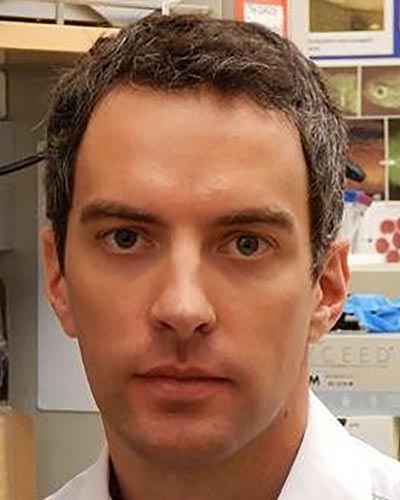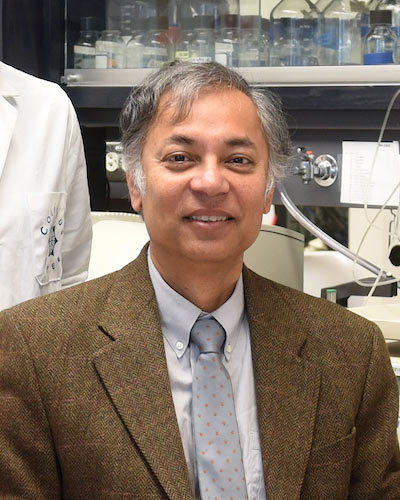July 29, 2022 | Heide Aungst
A Probiotic Bacteria Strain in Preemies Seems to Protect and Strengthen the Gut
Human breastmilk has long been considered “liquid gold” among clinicians treating premature infants in a newborn intensive care unit (NICU). Breastmilk-fed “preemies” are healthier, on average, than those fed formula. Why is that true, however, has remained a mystery.
 New research from the University of Maryland School of Medicine’s (UMSOM) Institute for Genome Sciences (IGS), published online in the journal mBio in June found it is not just the content of breastmilk that makes the difference. It is also the way the babies digest it.
New research from the University of Maryland School of Medicine’s (UMSOM) Institute for Genome Sciences (IGS), published online in the journal mBio in June found it is not just the content of breastmilk that makes the difference. It is also the way the babies digest it.
The research, led by Bing Ma, PhD, Assistant Professor of Microbiology and Immunology at UMSOM and a researcher at IGS, discovered a strain of the Bifidobacterium breve bacteria or B. breve in the gut of breastfed babies who received higher volumes of breastmilk than their counterparts. Those preemies had better nutrient absorption because they developed an intact intestinal wall, one week after birth. B. breve was much less prevalent in both formula-fed babies and breastfed babies with “leaky gut.” Babies with leaky gut do not develop a barrier to protect against bacteria and digested food from getting into the bloodstream. For the first time, the team also found that the way B. breve metabolizes breastmilk keeps breastfed babies healthier and allows them to gain weight by strengthening their underdeveloped intestinal barrier.
An immature or “leaky” gut can lead to necrotizing enterocolitis (NEC), which is the third leading cause of newborn death in United States and worldwide. In fact, NEC impacts up to 10 percent of premature babies with a devasting mortality rate as high as 50 percent.
“Our discovery could lead to promising and practical clinical interventions to strengthen the babies’ gut and, therefore, increase survival rates of the most vulnerable preemies,” said Dr. Ma.
Bifidobacterium in the gut or microbiome has long been known to have health benefits. It includes a diverse set of strains that have very different properties. Some strains are only found in adults; some are mostly in adolescence. One strain, Bifidobacterium infantis, has been seen predominantly in full-term infants.
The researchers followed 113 premature babies who were born between 24 and 32 weeks’ gestation. This study found Bifidobacterium breve (B. breve) only in preemies who had improved gut barrier function within one week after birth. Dr. Ma and her colleagues discovered that Bifidobacterium breve is genetically equipped to digest nutrients within the cell membrane rather than the more typical external digestion process in which bacteria secrete digestive enzymes onto nutrients to break them down.
At the most basic level, the gut microbiome in these breastfed preemies with more B. breve metabolizes carbohydrates differently than it does formula. The researchers say they hypothesize that this process of metabolism then strengthens and matures the intestinal barrier faster, protecting fragile newborns from disease.
 “We now know that it is not the breastmilk alone that helps preemies develop their intestinal barrier faster,” Dr. Ma said. “We will need to find the best way to prophylactically administer B. breve early in life, rather than rely on transmission from breastmilk or even the mother’s gut or vaginal microbiota during the birthing process. This is especially critical in formula-fed preemies.”
“We now know that it is not the breastmilk alone that helps preemies develop their intestinal barrier faster,” Dr. Ma said. “We will need to find the best way to prophylactically administer B. breve early in life, rather than rely on transmission from breastmilk or even the mother’s gut or vaginal microbiota during the birthing process. This is especially critical in formula-fed preemies.”
Dr. Ma said that more studies are needed to determine if the B. breve originated in the breastmilk, gut, mother’s vagina, or even environment.
Albert Reece, MD, PhD, MBA, Executive Vice President for Medical Affairs, University of Maryland, Baltimore, the John Z. and Akiko K. Bowers Distinguished Professor, and Dean at UMSOM said, “This research can have a far-reaching impact globally. It could ultimately save thousands of premature babies from permanent disability or death associated with an immature and permeable intestine that allows deadly bacteria in.”
Authors from the Institute for Genome Sciences include Dr. Ma; Michael France, PhD, Post-Doc Fellow; Elias McComb, BS, Research Technician; Lindsay Rutt, MS, Laboratory Research Manager; Pawal Gajer, PhD, Research Associate, Microbiology and Immunology; Li Fu, BS, Laboratory Research Specialist; Hongqiu Yang, PhD, Microbiome Service Laboratory; Mike Humphrys, MS, Microbiome Service Laboratory Director; Luke J. Tallon, BA, Executive Scientific Director, Maryland Genomics; Lisa Sadzewicz, PhD, Executive Director, Maryland Genomics Administration; and Jacques Ravel, PhD, Professor of Microbiology and Immunology, Associate Director, Genomics, and Interim Director, IGS.
Authors from other departments within the University of Maryland School of Medicine include Sripriya Sundararajan, MBBS, MD, Associate Professor of Pediatrics and Neonatal Director of OB-MFM Relations; Gita Nadimpalli, MD, PhD, MPH, Graduate Research Assistant; Jose M. Lemme-Dumit, PhD, Post-Doc Fellow, Pediatrics; Elise Janofsky, Pediatrics; Lisa S. Roskes, MD, Pediatrics; Marcela F. Pasetti, PhD, Professor of Pediatrics, Microbiology and Immunology; and Rose M. Viscardi, MD, Professor Emeritus of Pediatrics and Medicine.
This study was supported in part by a Gerber Foundation 2018 award (project identifier 6361), the National Institutes of Health’s National Institute of Diabetes and Digestive and Kidney Diseases (NIDDK) (grant number R21DK123674), and the Institute for Clinical and Translational Research (ICTR) at the University of Maryland Accelerated Translational Incubator Pilot (ATIP) award.
The authors have no conflict of interest.
About the University of Maryland School of Medicine
Now in its third century, the University of Maryland School of Medicine was chartered in 1807 as the first public medical school in the United States. It continues today as one of the fastest growing, top-tier biomedical research enterprises in the world -- with 46 academic departments, centers, institutes, and programs, and a faculty of more than 3,000 physicians, scientists, and allied health professionals, including members of the National Academy of Medicine and the National Academy of Sciences, and a distinguished two-time winner of the Albert E. Lasker Award in Medical Research. With an operating budget of more than $1.3 billion, the School of Medicine works closely in partnership with the University of Maryland Medical Center and Medical System to provide research-intensive, academic and clinically based care for nearly 2 million patients each year. The School of Medicine has nearly $600 million in extramural funding, with most of its academic departments highly ranked among all medical schools in the nation in research funding. As one of the seven professional schools that make up the University of Maryland, Baltimore campus, the School of Medicine has a total population of nearly 9,000 faculty and staff, including 2,500 students, trainees, residents, and fellows. The combined School of Medicine and Medical System (“University of Maryland Medicine”) has an annual budget of over $6 billion and an economic impact of nearly $20 billion on the state and local community. The School of Medicine, which ranks as the 8th highest among public medical schools in research productivity (according to the Association of American Medical Colleges profile) is an innovator in translational medicine, with 606 active patents and 52 start-up companies. In the latest U.S. News & World Report ranking of the Best Medical Schools, published in 2021, the UM School of Medicine is ranked #9 among the 92 public medical schools in the U.S., and in the top 15 percent (#27) of all 192 public and private U.S. medical schools. The School of Medicine works locally, nationally, and globally, with research and treatment facilities in 36 countries around the world. Visit medschool.umaryland.edu
About the Institute for Genome Sciences
The Institute for Genome Sciences (IGS) at the University of Maryland School of Medicine has revolutionized genomic discoveries in medicine, agriculture, environmental science, and biodefense since its founding in 2007. IGS investigators research areas of genomics and the microbiome to better understand health and disease, including treatments, cures, and prevention. IGS investigators also lead the development of the new field of microbial forensics. IGS is a leading center for major biological initiatives currently underway including the NIH-funded Human Microbiome Project (HMP) and the NIAID-sponsored Genomic Sequencing Center for Infectious Diseases (GSCID). Follow us on Twitter @GenomeScience.
Contact
Heide Aungst
HAungst@som.umaryland.edu
216-970-5773 (cell)
Related stories

Wednesday, July 19, 2023
New Innovation in CAR T-Cells Paves Way for Less Toxic Therapy Against Multiple Myeloma
University of Maryland School of Medicine (UMSOM) researchers engineered a new type of CAR T-cell therapy that, in preclinical studies, selectively attacked cancer cells while sparing healthy cells, potentially reducing the likelihood of toxic side effects from this innovative cancer treatment. The cells were designed specifically to attack multiple myeloma, a cancer of the plasma cells found in the body’s bone marrow.

Wednesday, April 05, 2023
Understanding E. Coli Strains That Do Not Cause Diarrhea Could Lead to New Treatments
News reports featuring E. coli often tell terrifying stories of intestinal illness and diarrhea or deadly outbreaks from contaminated food. There are, however, many different strains of the bacteria E. coli, or Escherichia coli, and not all are bad.

Monday, September 20, 2021
UM School of Medicine Receives $7.5 Million Grant to Create Complex Model of Female Reproductive Tract to Study Infections
Researchers at the Institute for Genome Sciences (IGS) at the University of Maryland School of Medicine have received a $7.5 million federal grant to create a complex model of the female reproductive system in order to study sexually transmitted infections (STIs). They plan to create a realistic 3D model that integrates vaginal and cervical epithelial cells and the bacteria that colonize these cells, called a microbiome. They aim to use this model to identity factors that play a role in chlamydia and gonorrhea infections experienced by a growing number of women in the U.S. and worldwide.

Wednesday, February 26, 2020
Researchers Develop First Catalogue of Genes that Comprise Community of Microbes in Vaginal Microbiome
University of Maryland School of Medicine’s (UMSOM) Institute for Genome Sciences (IGS) researchers have created the first catalogue of genes that comprise the community of microbes, which inhabit the human vagina. The catalogue, called human vaginal non-redundant gene catalog (VIRGO), was recently released as a public resource that can be used by researchers to facilitate a more in-depth understanding of the role of vaginal microorganisms in women’s health and to potentially develop future treatments for certain gynecologic conditions.

Tuesday, December 19, 2017
UMSOM Scientists Identify Key Factors that Help Microbes Thrive in Harsh Environments
Three new studies by University of Maryland School of Medicine (UMSOM) scientists have identified key factors that help microbes survive in harsh environments.

